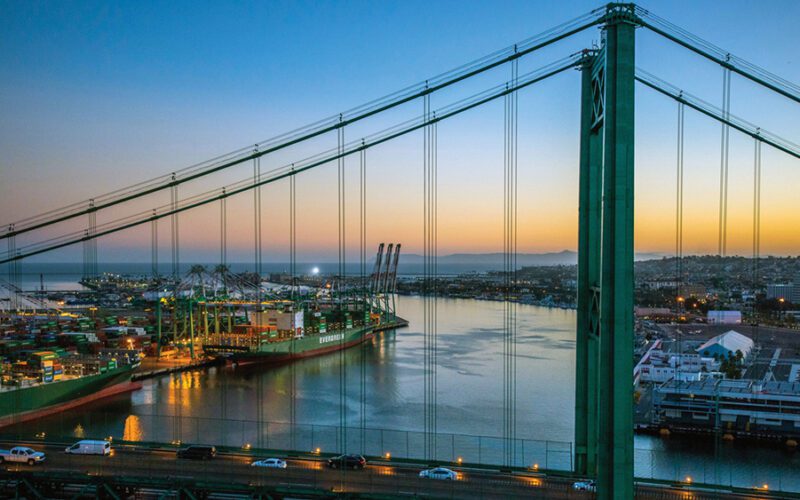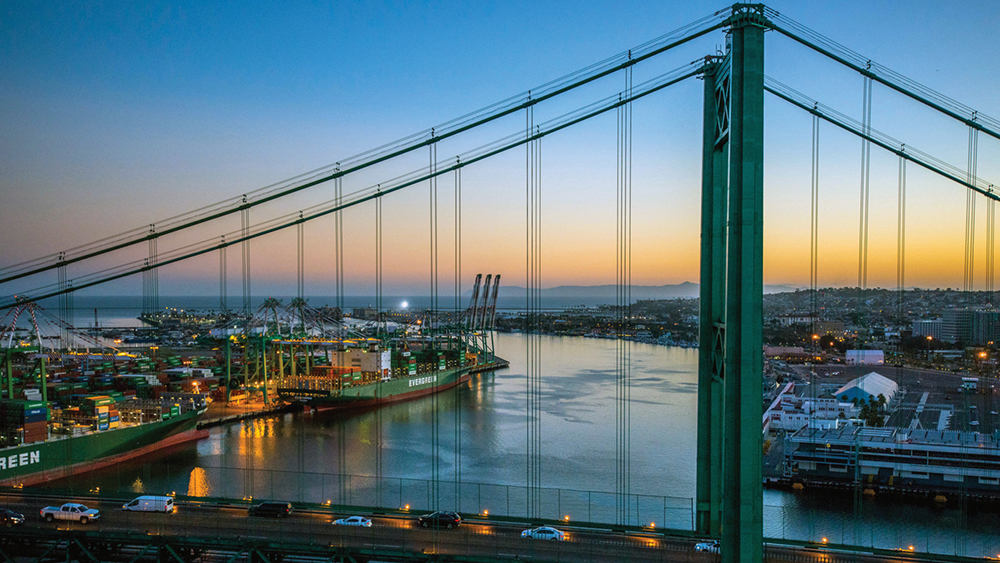
A number of big and small West Coast ports are approaching coming out of the COVID-19 pandemic by investing in their future via innovative and forward-looking infrastructure projects.
Several of the larger ports are focusing on modernizing their terminals, enhancing rail systems, reducing emissions and/or transitioning to hybrid, increasing shore power and designing projects that aim to improve efficiency and accommodate bigger ships.
Here are some of the highlights of the projects:
PORT OF LOS ANGELES
The Los Angeles Board of Harbor Commissioners recently adopted a $1.9-billion budget for fiscal year 2022-23, much of which will be reinvested into the Port of L.A. following a record setting year in 2021 for containerized cargo volume.
Focused on improving the port’s operational strength and financial sustainability, the POLA’s Capital Improvement Program for FY 2022-23 includes $180.5 million for terminal, transportation, security and public access projects.
Funding for terminal construction projects in the coming year includes $34.3 million for the Pier 400 Corridor Storage Track Expansion and $17.4 million for improvements at the Shell and PBF marine oil terminals.
Among the environmental programs in the budget is the Clean Truck Program, which will use fees collected to promote and incentivize the phase out of older, more polluting trucks serving the San Pedro Bay port complex.
The budget also includes support for near-zero and zero-emission technology demonstration projects. The Port is currently either leading or participating in 16 regional projects with multiple partners and global brands to demonstrate low nitrogen oxide (NOx) and zero-emissions trucks, yard tractors, forklifts and other equipment.
Street and Bridge Interchanges
An important interchange that acts as an access link to the L.A. waterfront, the residential community of San Pedro, Terminal Island and the West Basin Container Terminal, will get an overhaul starting this summer.
The state Route 47/Vincent Thomas Bridge and Front Street/Harbor Boulevard interchange will be reconfigured with a number of enhancements.
“The project will improve operational and safety deficiencies at the SR-47/110/Harbor interchange,” Project Manager Sarah Aziz explained.
The project is scheduled for construction to start in summer 2023.
Southbound SR-47 traffic will now exit north of the mainline onto Front, allowing direct-through movement for truck traffic into the West Basin Container Terminal and dual-right movement for passenger vehicles to southbound Harbor Boulevard, Aziz said.
In addition, the project is expected to increase the merge distance heading onto the northbound SR-47 from the boulevard, allowing for safer transitions onto the mainline as well as an auxiliary lane to separate traffic coming off the southbound 110 and Gaffey Street exit.
Other improvements include pavement, curb and gutter, street lighting, signal, drainage and landscape work along Front Street/Harbor Boulevard from Pacific Avenue to Swinford Avenue. Architectural wall treatments are proposed for new and existing structures along the boulevard exit ramp.
The $70.5 million project includes $70.2 million in grant funding, according to the Port of Los Angeles 2022-23 fiscal year proposed budget.
Another project currently under construction at the port is the Alameda Corridor Southern Terminus Gap closure. It’s substantially complete and expected to close out next month, confirmed Project Manager Noe Preciado. There are no major issues and it’s on time and within budget, he added.
The project entailed construction of about 5,000 feet of mainline track at the port, eliminating a short gap of single track serving the TraPac and West Basin Container Terminal on-dock railyards, Preciado explained.
This project accommodates increased loading of trains, which reduces truck trips to off-dock railyards and the potential for train and train-vehicular collisions.
This $17.3 million project also includes relocation and protection of existing underground utilities and relocation of power poles, utility meters and perimeter fencing, according to the port’s 2022-23 budget.
The project budget includes $6 million in Trade Corridor Enhancement Program (TCEP) funding by the state of California.
Begun in April 2021, construction is expected to be completed later this year.
Pier 400 Storage Yard
The existing Pier 400 rail storage yard is in need of expansion to accommodate future rail volumes on Terminal Island, according to port officials, so a project currently under construction covers expansion of the corridor storage track.
The project scope includes an extension to the existing rail bridge, five new railroad storage tracks, an asphalt-access roadway, new crossovers and switches, as well as modifications to the existing compressed air system of the Pier 400 rail storage yard and bridge.
Plans also call for relocation of a portion of the Pier 400 lead track onto port property, realignment of the track connection to the existing rail storage yard, modifications to Reeves Avenue and relocation of the existing at-grade crossing at Nimitz Avenue to Reeves Avenue.
The project is currently budgeted at $73.2 million and was awarded about $21.6 million of TCEP funding by the state of California.
Construction began in February and completion is expected in 2024.
The Pier 400 Corridor Storage Track Expansion project is on track and on schedule, Port of LA Chief Harbor Engineer Shaun Shahrestani confirmed. There are no issues or changes at this point and none expected, he added.
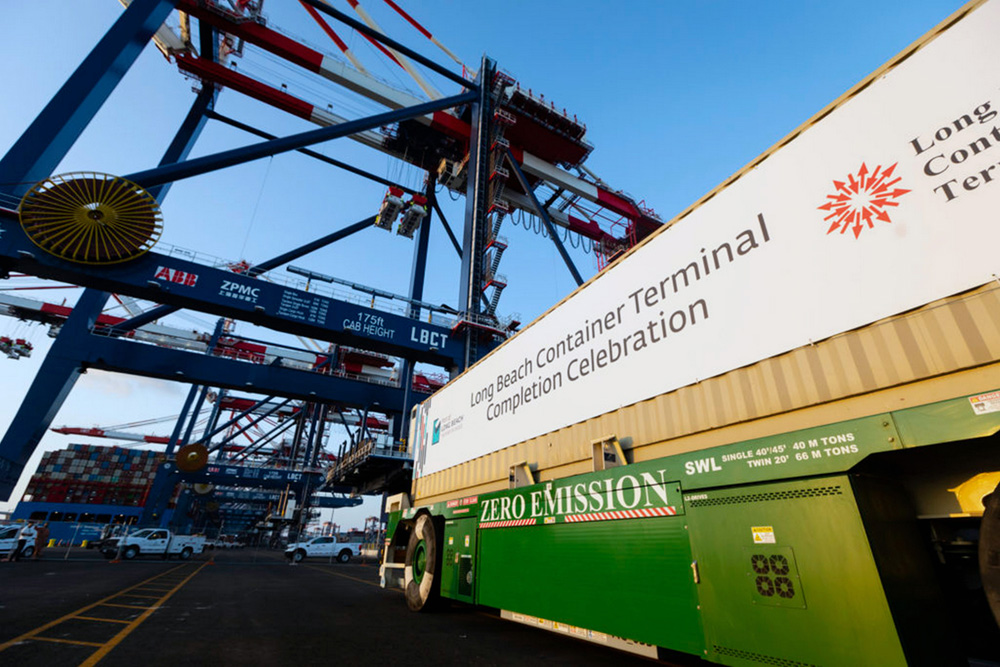
PORT OF LONG BEACH
A major project currently underway at the Port of Long Beach is the new Pier B on-dock rail support facility.
Plans call to reconfigure, expand and enhance the existing Pier B rail yard, and directly connect to on-dock rail facilities and the Alameda Corridor railway. The goal is to enhance on-dock rail capacity at the port’s shipping terminals, speeding the movement of cargo.
By allowing longer trains to be assembled with greater frequency, the new facility would dramatically streamline rail operations and minimize the increase in truck trips as cargo volume grows, Port of Long Beach Deputy Chief Harbor Engineer Mark Erickson said.
And moving cargo by on-dock rail is cleaner and more efficient, as it reduces truck traffic, he added. The project is expected to improve rail operations throughout the San Pedro Bay ports complex resulting in moving more cargo with less of an environmental impact, easing roadway traffic congestion and improving air quality.
“It is the centerpiece of the Port of Long Beach’s rail infrastructure program,” Erickson said. “In essence, the facility enhances the port’s ability to hold trains for a short period of time, so the terminals and railroads can operate more efficiently.”
Enhancing on-dock rail capacity is expected to help to strengthen the port’s ability to compete for cargo, he added.
The project is also necessary to shift more cargo to rail and meet the port’s goal of moving 35% of containers by on-dock rail, one of the goals of the 2017 update of the San Pedro Bay Ports’ Clean Air Action Plan, Erickson explained.
It’s on schedule, he noted, and they are aiming to break ground in 2023. Phase 1 rail work is expected to be finished in 2025, doubling the capacity of the existing Pier B rail yard. Full project completion is planned for 2032.
The Long Beach Harbor Commission approved the program in September 2018, but the project has been planned since 2007.
“A project of this magnitude takes a lot of time and a lot of planning,” Erickson said.
The $1.547-billion project encompasses about 171 acres in the Harbor District south of 12th Street, north of Pier B Street and west of the 710 Freeway. The port will need to acquire some properties in the project’s footprint.
In December, the U.S. Department of Transportation recognized the national significance of this project with a $52.3 million grant.
“We’re also continually in search of funding partners,” Erickson said.
The port has been working with grant funders and potential partners, including the Los Angeles County Metropolitan Transportation Authority (Metro), the California Department of Transportation (Caltrans) and the U.S. Department of Transportation.
To date, Long Beach has received almost $79 million in grant funds. Metro awarded $10 million to the project under the Measure R, I-710 Early Action Fund Program. Additionally, the Port received $16.3 million in federal transportation bill funding managed by Metro and Caltrans and $52.3 million from the U.S. Maritime Administration’s (MARAD) Port Infrastructure Development Program.
Middle Harbor Redevelopment
The port, partnered with Long Beach Container Terminal, also recently completed another major project after a decade of construction.
A grand opening was held Aug. 20, 2021, to celebrate the completion of the Middle Harbor Redevelopment Project, which transformed two aging terminals into one of the world’s most technologically advanced and greenest container terminals.
The 304-acre terminal is home to a 4,200-foot-long wharf, which will welcome the world’s biggest container ships. Up to three 14,000-TEU (twenty-foot equivalent units). ships can shut down their diesel engines and simultaneously plug into shore power. LBCT is powered almost entirely by electricity and has an annual capacity of 3.3 million TEUs.
The port invested nearly $1.5 billion in infrastructure over three phases of development of the terminal at Middle Harbor. LBCT contributed another $700 million for cargo-handling equipment, highly sophisticated computer and software systems and workforce training.
Other highlights include 14 of the world’s first tandem-lift, dual-hoist ship-to-shore cranes, each of which can discharge or load four TEUs at the same time and handle up to 35 container moves per hour; 102 electrified automated guided vehicles that transport containers between the docks and the yard, and 72 electric automatic stacking cranes that manage container staging, priorities and movements.
The project’s successful completion represents change that goes way beyond clean infrastructure and equipment, said Rick Cameron, the port’s deputy executive director of planning and development.
“It changed how we analyze projects, how we negotiate leases, how we engage with the industry, other agencies and the community,” he said.
The project also included mitigation measures aimed at reducing energy consumption, including cranes that have regenerative power capabilities on down cycles and solar panels throughout the facility.
Also, vessels calling at the terminal are required to use low-sulfur fuel and be able to reduce vessel speeds to 12 knots within 40 nautical miles of Point Fermin. All container ships at berth also must plug into shoreside electric power—a lease condition more stringent than California’s requirement to plug in 80% of all container, cruise and refrigerated or reefer vessels at the state’s largest ports.
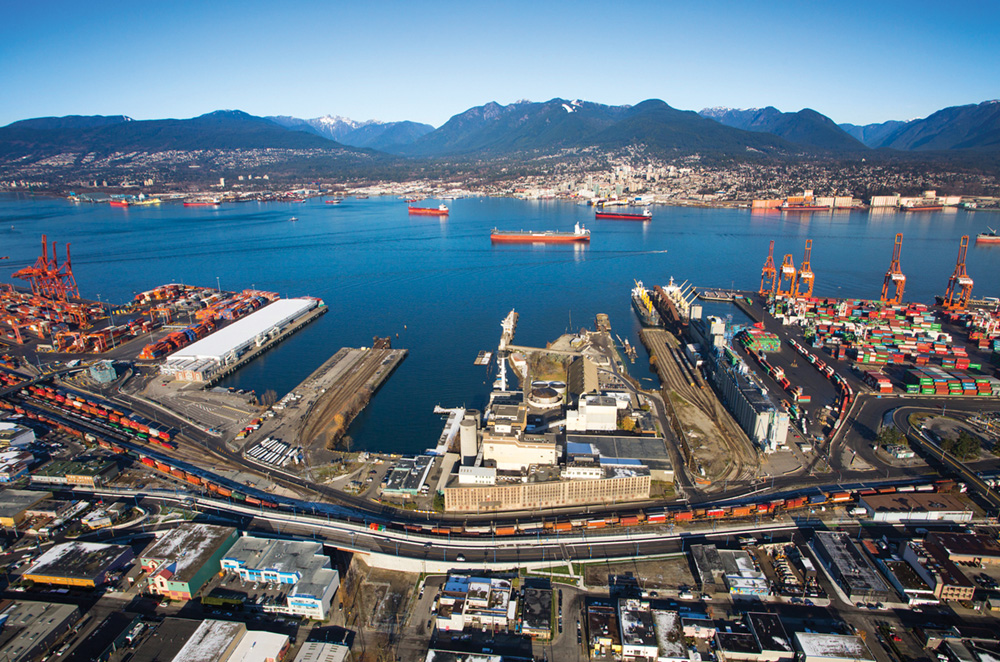
PORT OF VANCOUVER
The Vancouver Fraser Port Authority is building the Centerm Expansion Project and South Shore Access Project to help meet increasing demand for containers shipped through the Port of Vancouver.
The project includes construction of new port land through infill to expand the terminal footprint by 15% and reconfiguration of the Centerm container terminal. Plans also call for: creation of a new overpass on Centennial Road; changes to Waterfront Road to create a continuous port road from Canada Place to Highway 1; removal of the Heatley Road overpass, and coordination with tenants on road maintenance within port lands.
This work will increase container-handling ability at Centerm Terminal by two-thirds, from 900,000 TEUs to 1.5 million TEUs. By increasing the terminal footprint by only 15% and rearranging operations, terminal operator DP World would be able to handle a more than 60% increase in containers.
The aim is to remove trade bottlenecks while delivering improved port roads, reduced travel delays and congestion, better emergency response, lower greenhouse gas (GHG) emissions and additional job opportunities.
The port authority said that it completed extensive environmental and technical studies, along with three rounds of public engagement to inform the construction planning.
Port officials hope the project increases capacity at Centerm to support Canada’s growing trade demand for goods shipped in containers. The project should also provide a continuous port road from Canada Place to Highway 1 and reduce travel delays for port users and businesses by building an overpass over two rail crossings and removing one crossing on port roads.
Discussions began in 2015 with partners, indigenous groups, local government and key stakeholders. After the preliminary comment period, technical and environmental studies and other early work, construction began in July 2019, with in-water work following in August 2019.
Last summer, crews completed the Centennial Road overpass; this summer, officials are aiming to finish the Heatley Road overpass removal. Construction is slated for a 2023 completion.
Roberts Banks Project
The proposal for the Roberts Bank Terminal 2 Project, located to the northwest of the existing Roberts Bank terminals, includes a new three-berth marine container terminal which will be placed in deep, subtidal water away from sensitive intertidal habitats.
The project is needed to ensure Canada is able to meet its trade objectives through the late 2030s. If approved and built, it would play a critical role in supporting Canadian exporters and consumers of goods who increasingly want to trade with economies around the world.
Environmental work, including scientific field work at Roberts Bank, is ongoing and port officials continue to engage with communities and consult with indigenous groups.
It is being funded by the port authority and private investment.
In addition to the three-berth marine container terminal, the proposed project calls for a widened causeway to the mainland to accommodate additional road and rail infrastructure and an expanded tug basin to accommodate a second tug operations contractor.
Officials chose Roberts Bank as the location for the project because the area has the deep water necessary to accommodate large container ships and is located close to major transportation corridors, according to the port authority.
The project is subject to regulatory approvals, environmental authorizations, permits, market conditions and a final investment decision. Construction is expected to take about six years.
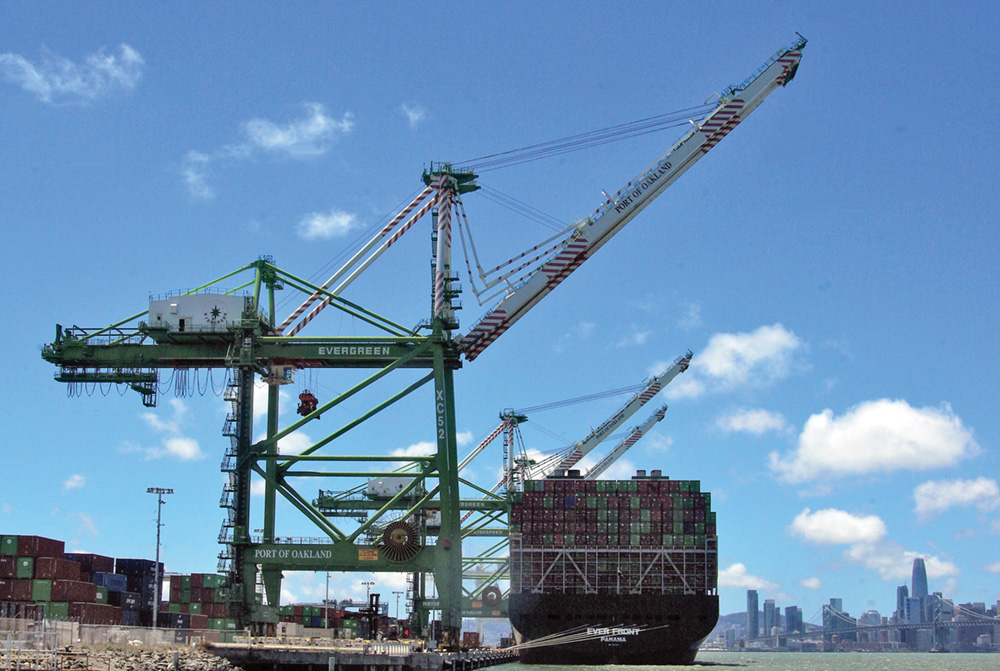
PORT OF OAKLAND
The Port of Oakland is working on a solution to improve traffic flow and reduce congestion.
The Freight Intelligent Transportation System (FITS) program includes 15 freight technology demonstration projects designed to address traffic management, security systems and roadway improvements at the Oakland seaport. It will also update security systems and provide a common communication platform for first responders.
Construction for FITS is expected to be completed this September, confirmed Port of Oakland spokesperson Marilyn Sandifur. The next step will be a testing period lasting anywhere from six months to one year.
Port officials anticipate FITS to be fully “live” by spring/summer 2023.
The Alameda County Transportation Commission received $12.45 million from the California Transportation Commission for the implementation of the FITS program at the port. Funding comes from California Senate Bill 1.
Some examples of FITS demonstration projects: an interagency emergency operations and traffic management center; WiFi for truckers to access traffic and terminal gate updates; changeable message signs to show traffic delays for truckers; vehicle queue detection for accurate measurement of truck turn times, and a mobile phone app for truckers.
‘Pop Up’ Container Yard
There’s a new temporary container yard at the Port of Oakland to provide access to containers for agricultural exporters. The “pop up” yard opened on March 7 with financial support from the federal government.
As ocean carriers bypassed traditional channels in order to rush containers back to be exported empty, fewer containers are available for U.S. agricultural commodities, port officials explained. As a result, many of these carriers have suspended service to the Port of Oakland.
The Howard Terminal “pop up” site will provide space to prepare empty containers. It offers easier access for agricultural companies, which will help restore shipping services to agricultural commodities while relieving congestion.
The intent is to ease the pain of a year-long supply chain disruption that’s impeding farm trade, port officials noted in a June statement. The port added that restoration of vessel service is essential to resolving Oakland’s supply-chain challenges; ocean carriers have been skipping Oakland due to vessel logjams in Southern California.
The port said the U.S. Department of Agriculture (USDA) would make direct payments to farm producers shipping overseas. The program is available to exporters using container ports in Oakland, Seattle or Tacoma.
“Our partnership with the USDA to open a temporary pop-up yard will go a long way in helping ag exporters,” the port’s Maritime Director Bryan Brandes said. “At the same time, we still need the shipping lines to bring back vessel service to Oakland to address the high demand of export volume.”
Here’s how it would work:
The USDA would pay ag shippers $200 for every container of farm goods they export.
Exporters using refrigerated containers for perishable commodities would receive $400 per container.
Exporters would receive an extra $125 for every empty container they pick up at a designated Oakland storage depot.
The USDA payments are meant to offset shipping costs due to global supply-chain issues and the expense of additional container moves.
Large Distribution Warehouse
Port of Oakland officials say that a new development at Oakland is now the largest distribution facility at any U.S. West Coast port. Industrial real estate giant CenterPoint Properties built the massive, 460,000-square-foot warehouse at 1300 Maritime Street last year.
In January, a major logistics company, PCC Logistics, became the tenant at the enormous new warehouse at the Port of Oakland’s designated Seaport Logistics Complex.
“This effectively marks the launch of the port’s Seaport Logistics Complex, a long-awaited re-use of land that was once occupied by the US Army,” Port of Oakland Executive Director Danny Wan said. “The warehouse construction supported local jobs and now with a tenant moving in, that means more jobs being generated here in Oakland.”
An agreement was approved by the Oakland Board of Port Commissioners in November 2017. The deal became official in January 2018. The agreement with Oakland called for CenterPoint to develop a $52-million logistics facility on port property. A building permit was approved in July 2019 and the facility was constructed in 2021.
The Seaport Logistics Complex is expected to eventually cover 180 acres of port land.
Widening Turn Basins
The port’s Turning Basins Widening Study reached a key milestone earlier this year. The port released A Notice of Preparation to begin an environmental review per the California Environmental Quality Act (CEQA) in late May.
Partnering with the U.S. Army Corps of Engineers, the port will study widening Oakland’s federal turning basins. A draft Environmental Impact Report is expected to be available for public review in early 2023.
According to Oakland officials, the basins were originally designed for ships that are shorter than today’s big and long container ships that move goods in the transpacific trade lanes. These large vessels now have transit restrictions at Oakland, which lead to some delays.
Port officials hope the study will determine if widening the basins is feasible and if it would support better maneuverability for big ships.
The study phase is anticipated to conclude mid-2023. Pending various discretionary approvals and funding, design efforts for the selected turning basins are expected to begin in late 2023.
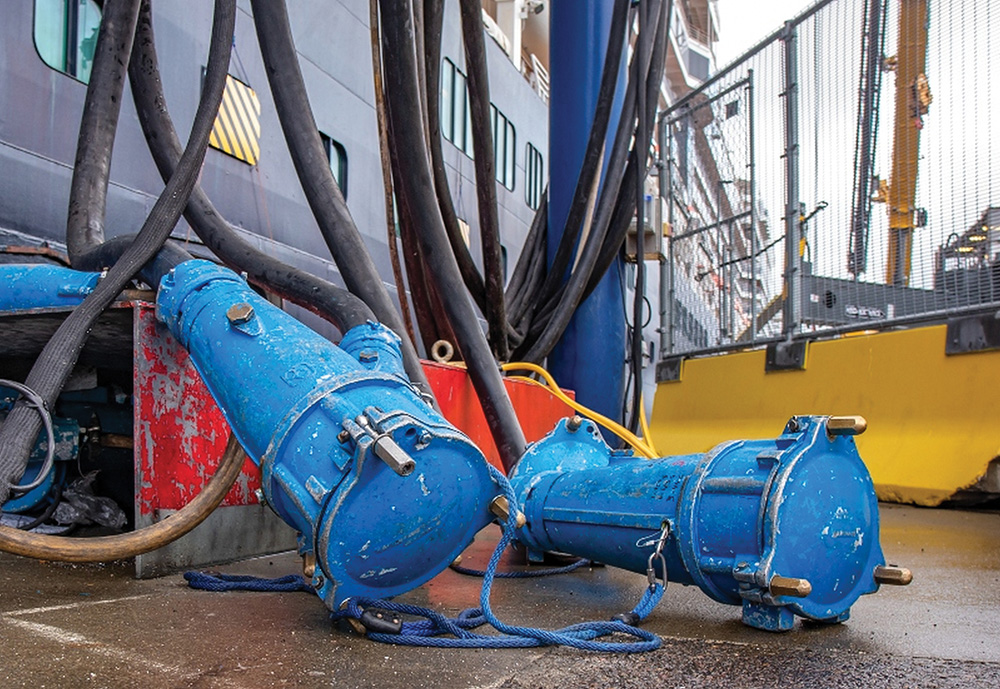
SEATTLE & TACOMA
In the Pacific Northwest, the major project on the books is the Northwest Seaport Alliance’s Terminal 5 modernization project.
The project is a more than $500-million investment to increase the international container capacity in Seattle, NWSA officials explained.
“We’re bringing extra capacity to the Pacific Northwest with Terminal 5 having the world’s largest container cranes,” said Don Meyer, NWSA Co-Chair and Port of Tacoma president. “The Terminal 5 modernization is improving not only the berthing space for the vessels, but also the efficiency of the terminal. “
Construction is in two phases. The first opened in January and is operated by SSA Terminals. Phase one construction includes a modernized berth and four new super-post-Panamax cranes, Northwest Seaport Alliance spokesperson Melanie Stambaugh explained.
Phase Two is currently under construction and would add a second rebuilt berth with four additional super-post-Panamax cranes to Terminal 5. Phase two is expected to be operational in mid-2023 with full completion in early 2024.
When complete, the terminal will boast 185-acres of terminal capacity, on-dock rail, 1,500 reefer plugs, shore power capability and eight super-post Panamax cranes.
Phase one’s completion is expected to add up to 300,000 lifts per year. When phase two is operational, officials anticipate an additional 500,000 lifts annually.
The benefits of Terminal 5 expand across Washington state and into the Midwest: about half the cargo imported through NWSA terminals moves on to inland destinations. Terminal 5 will expedite this process as imports can be loaded onto the on-dock rail and to be sent inland. Exports would move through Terminal 5 from the inland rail ramps in Minot, N.D. and Pocatello, Idaho to international markets.
The Terminal 5 investment also incorporates environmental protections such as a stormwater system and shore power access.
The opening of Terminal 5 spreads the cargo volume across the gateway, allowing customers to perform their business in a much easier manner, NWSA CEO John Wolfe explained.
“With the development of Terminal 5, we have focused aggressively on environmental standards that are state-of-the-art including shore power for vessels that have the capability to plug-in while they are at berth, and (a) state-of-the-art stormwater system that captures the stormwater before it enters into Elliott Bay,” he said.
Beyond the terminal , the NWSA is in the beginning stages of expansion projects at several terminals in the Tacoma Harbor and planning to add a one-berth cargo facility in the Seattle Harbor starting 2023. The NWSA is also working closely with the U.S. Army Corps of Engineers to undergo harbor deepening in both Seattle and Tacoma.
The NWSA modernization of the Terminal 5 facility in Seattle includes the installation of shore power at both berths, Port of Seattle spokesman Peter McGraw added. The initiative is partially funded by a special appropriation from the state of Washington.
The TOTE Maritime terminal in Tacoma has been equipped with shore power since 2010. The two TOTE vessels on regular service between Tacoma and Alaska call weekly and plug in to the grid while they are at dock in Tacoma.
In addition, the NWSA is working on adding shore power capabilities to its newly modernized Pier 3 and Pier 4 facilities in Tacoma. The shore power system is being partially funded through grants from the federal Diesel Emission Reduction Act program and the TransAlta Coal Transition Grant Program’s Energy Technology Fund.
The alliance plans to expand shore power capabilities to other large international container terminals in Tacoma and Seattle, including Terminal 18 in Seattle and Washington United Terminal and Pierce County Terminal in Tacoma.
One significant project is to incorporate shore power into the Bell Street Cruise Terminal at Pier 66 using an underwater cable on the floor of Elliott Bay – essentially a giant, heavy-duty waterproof extension cord.
Once complete, shore power at the pier could help avoid emitting an estimated 3,000 metric tons of CO2 if all home port ships connect.
Sara Hall has 15 years of experience at several regional and national magazines, online news outlets, and daily and weekly newspapers, where coverage has included reporting on local harbor activities, marine-based news, and regional and state coastal agencies. Her work has included photography, writing, design and layout.

